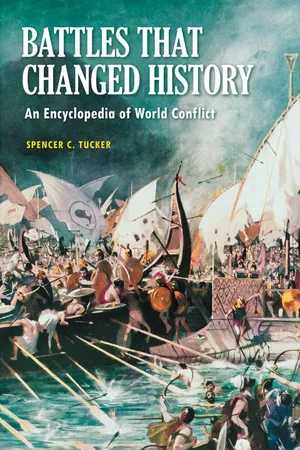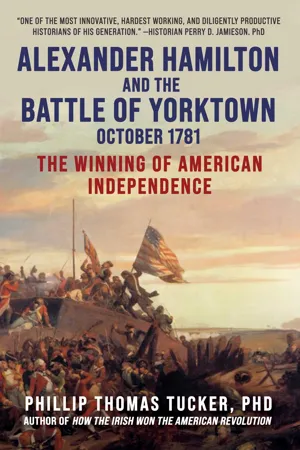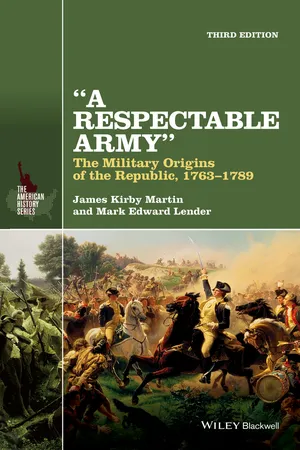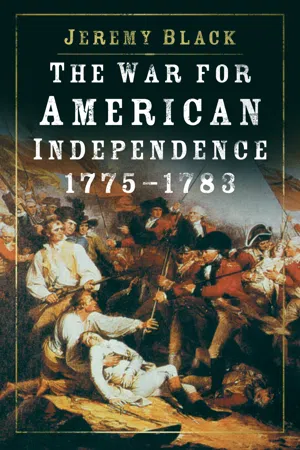History
Battle of Yorktown
The Battle of Yorktown, fought in 1781 during the American Revolutionary War, was a decisive victory for the American and French forces over the British. General George Washington and French General Comte de Rochambeau led the siege, which ultimately led to the surrender of British General Cornwallis and his troops. This significant battle effectively ended major combat operations in North America.
Written by Perlego with AI-assistance
Related key terms
1 of 5
7 Key excerpts on "Battle of Yorktown"
- eBook - PDF
Battles that Changed History
An Encyclopedia of World Conflict
- Spencer C. Tucker(Author)
- 2010(Publication Date)
- ABC-CLIO(Publisher)
Thus, a tactically inconclusive naval battle ranks as one of the most significant strategic victories in world history. References Larrabee, Harold A. Decision at the Chesapeake. London: William Kimber, 1965. Syrett, David. The Royal Navy in American Waters, 1775–1783. Aldershot, UK: Scolar Press, 1989. Tilley, John A. The British Navy and the American Revolution. Columbia: University of South Carolina Press, 1987. Siege ofYorktown Date September 28–October 19, 1781 Location Yorktown, Virginia on the Chesapeake Bay (eastern United States) Opponents (* winner) *Americans and French British Commander General George Washington (Americans); Lieutenant General Jean Baptiste Donatien de Vimeur, Comte de Rochambeau (French) Lieutenant General Charles, Earl Cornwallis Approx. # Troops 9,000 Americans; 7,500 French 8,000 Importance Brings the collapse of Lord North’s cabinet and ushers in a new government pledged to negotiate an end to the war 252 | Siege ofYorktown The Battle of Yorktown in Virginia was the last great battle of the American Revolutionary War (1775–1783). By 1781 the war was in stalemate. In 1778 the British had shifted the emphasis to the south, securing Savannah and Charleston as well as most of Georgia and South Carolina. The British commander in the south, Lieutenant General Charles, Earl Cornwallis, had waged an aggressive campaign, but after sustaining heavy casualties in defeating Continental Army forces led by Major General Nathanael Greene in the Battle of Guilford Court House in March 1781, Cornwallis decided to march the majority of his forces north into Virginia. Continental Army commander General George Washington meanwhile hoped for a combined American and French assault on British-occupied New York. To- ward that end he had positioned his main forces at White Plains. - eBook - PDF
The Revolutionary Era
Primary Documents on Events from 1776 to 1800
- Carol Sue Humphrey(Author)
- 2003(Publication Date)
- Greenwood(Publisher)
The Battles of the Revolutionary War, 1 776- 1 78 1 61 Yorktown In the summer of 1781, Cornwallis took his army to Yorktown, Virginia, hoping to be resupplied by the British fleet. Washington, believing that he could box in Cornwallis with the help of the French fleet, moved his army to lay siege to Yorktown in September. This strategy worked. On October 19, 1781, Cornwallis surrendered his army. This American victory marked the end of the fighting in the Revolution. P A T R I O T V I E W George Washington: "Official Report" George Washington rejoicedgreatly in his victory over Cornwallis because he knew that it might be the last battle. Here, he praises both his own men and his French allies for their efforts in bringing about this very important victory. Freeman's Journal(Philadelphia), 31 October 1781 Head Quarters, Near York, 19 October 1781.1 have the honor to inform congress that a reduction of the British Army under the command of Lord Cornwallis is most happily effected. The unremitted ardour which actuated every officer and soldier in the combined army on this occasion has princi- pally led to this important event, at an earlier period than my most sanguine hopes had induced me to expect. The singular spirit of emulation which animated the whole army from the first commencement of our operations has filled my mind with the high- est pleasure and satisfaction and has given me the happiest presage of suc- cess. On the 17 th a letter was received from Lord Cornwallis, proposing a meeting of commissioners to consult on terms for the surrender of the posts of York and Gloucester. This letter (the first which had passed between us) opened a correspon- dence—a copy of which I do myself the honor to inclose—that correspon- dence was followed by the definite capitulation, which was agreed to and signed on the 19 th , a copy of which is also herewith transmitted, and which, I hope, will meet with the approbation of congress. - eBook - ePub
Alexander Hamilton and the Battle of Yorktown, October 1781
The Winning of American Independence
- Phillip Thomas Tucker(Author)
- 2022(Publication Date)
- Skyhorse(Publisher)
Chapter IIThe Long, Twisting Road and Strategic Situation that Led to YorktownSuccess in life, like in military campaigns, has often been first spawned from a series of setbacks and reversals until it appears that no hope for success possibly remains. The Yorktown Campaign is a classic example of this military truism, because a series of unprecedented American disasters across the South had the British extremely confident and complacent, when finally on the verge of winning the war by early 1781, or so it seemed. Consequently, what ultimately happened at Yorktown cannot be fully understood without examining the war in the South and the many humiliating fiascos and disastrous setbacks suffered by American forces. And the real story behind the Yorktown Campaign and the looming decisive victory for the allies was mostly about the power of the revitalized French Navy and its availability to serve in American waters.Fate and the accidents of history eventually united in unpredictable and accidental fashion to transfer the sleepy port in Virginia, once the state’s leading port on the Chesapeake before it lost its lofty status to other eastern towns with better harbors, into the most strategic and important point in America by the late summer of 1781. Only a few reminders of Yorktown’s former prosperity from the once-booming tobacco trade remained at the little port on the York River, including fine brick buildings and a nice harbor and wharf for deep-water vessels. As fate would have it, American independence was about to be ensured for all time by what was destined to happen at this obscure port along the south bank of the York River, where Washington and Rochambeau delivered their masterstroke. - eBook - ePub
A Respectable Army
The Military Origins of the Republic, 1763-1789
- James Kirby Martin, Mark Edward Lender(Authors)
- 2015(Publication Date)
- Wiley-Blackwell(Publisher)
As the defeated British columns began to parade that autumn afternoon, their musicians supposedly struck up a familiar melody, “The World Turned Upside Down.” No tune could have been more fitting. The mighty and proud had fallen. A small band of hardened American regulars, dreaming of a better life, had, with invaluable French assistance, endured the many dark days of despair following those of sunshine enthusiasm—and now beheld the prospect of complete triumph. Success at Yorktown would bring the cause of establishing a republican order in North America one more vital step closer to legitimacy in the minds of the indifferent and uncommitted. On the other side that day, the British had nothing to cheer. They had long since fumbled away the initiative in America—and also seemed to be losing it elsewhere across the globe. Whether the people of Britain would allow the war to continue, once they learned about Yorktown, had become the main question.The scene on the afternoon of October 19 was emotional, certainly because of everything it signified. The British war effort had suffered another devastating blow—the loss of an army numbering 7,200 or more. Washington, communicating with Congress, praised “the unremitting Ardor which actuated every Officer and Soldier in the combined Army” that “principally led to this Important Event.” Elsewhere on the field, a distraught British corporal spoke of his musket as he threw it on a pile of surrendered weapons: “May you never get so good a master again!”Formulating a Peace Settlement
Contrary to popular lore, the Yorktown triumph was not solely responsible for the first rush in British peace overtures. The situation was more complex. A look at the war map helps explain why the parent nation “had lost its nerve,” as Piers Mackesy has written. “It was the timing of the blow which mattered” in making Yorktown so significant.3 - eBook - ePub
Ghosts of the USS Yorktown
The Phantoms of Patriots Point
- Bruce Orr(Author)
- 2020(Publication Date)
- The History Press(Publisher)
I.THE HISTORYYORKTOWN A NAME OF HONORThe USS Yorktown (CV-10) is the second United States aircraft carrier to bear the name. She is the fourth of five United States ships to bear the name, a name that was taken from the Revolutionary War battle, the Battle of Yorktown. In order for one to appreciate the “Fighting Lady,” one must first understand the lineage of which she descends and the history that precedes her.THE BATTLE OF YORKTOWN : 1781The Battle of Yorktown was a decisive victory in the American Revolutionary War. It was a combined assault of American forces led by General George Washington and French forces led by Comte de Rochambeau against the British Army commanded by Lieutenant General Lord Cornwallis. It proved to be the last major land battle of the American Revolutionary War in North America. The surrender of Cornwallis’s troops prompted the British government to negotiate an end to the conflict.In 1780, 5,500 French soldiers landed in Rhode Island to assist the American forces. Washington, after having received communications from France, learned of the possibility of support from the French West Indies fleet of Comte de Grasse. Rochambeau and Washington decided to ask de Grasse for assistance in surrounding and capturing British occupied New York or, as another alternative, assistance in military operations against the Redcoats in Virginia. De Grasse informed them of his intent to sail to the Chesapeake Bay, Virginia, where Cornwallis had taken command. Cornwallis’s movements in Virginia had been covertly monitored by a Continental army reconnaissance force led by the Marquis de Lafayette.USS Yorktown (CV-10) is one of several ships to bear the name taken from the site of the famous Revolutionary battle. Courtesy of KOP.The French and American armies united north of New York City and began moving south toward Virginia. While en route, the Continental armies knew that they also were being monitored by British forces. Having this knowledge, they utilized it to their advantage to lead the British to believe a siege of New York was planned. Compte de Grasse sailed from the West Indies and arrived at the Chesapeake Bay at the end of August, bringing additional troops and providing a naval blockade of Yorktown. - eBook - ePub
- Jeremy Black(Author)
- 2021(Publication Date)
- The History Press(Publisher)
11
1781: Yorktown
Although I never dared promise myself that any exertions of mine, with my very reduced force (nearly one-third less than that of my predecessor) could bring the war to a happy conclusion; yet I confess that the campaign of 1781 terminated very differently from what I once flattered myself it would.The Narrative of Lieutenant-General Sir Henry Clinton (London, 1783) p. 5Cornwallis to Clinton, 26 May 1781… one maxim appears to me to be absolutely necessary for the safe and honourable conduct of the war, which is, that we should have as few posts as possible, and that wherever the king’s troops are, they should be in respectable force … In regard to taking possession of Philadelphia by an incursion, (even if practicable) without an intention of keeping or burning it (neither of which appear to be adviseable) I should apprehend it would do more harm than good to the cause of Britain … if offensive war is intended, Virginia appears to me to be the only province in which it can be carried on, and in which there is a stake, but to reduce the province and keep possession of the country a considerable army would be necessary, for with a small force, the business would probably terminate unfavourably, though the beginning might be successful … instead of thinking it possible to do anything in North Carolina, I am of the opinion, that it is doubtful whether we can keep the posts in the back part of South Carolina … the infinite difficulty in protecting a frontier of three hundred miles against a persevering enemy, in a country where we have no water communication and where few of the inhabitants are active or useful friends.War is a crucial business and the fate of the day after every possible precaution depends upon the most trifling incident .Nathanael Greene, 2 May 17811Thanks to Cornwallis’ surrender at Yorktown, 1781 witnessed the last real campaign of the war in America. Until then the war had not been as disastrous as had been feared and anticipated by some British participants and observers. Despite the anxieties expressed in 1778, French entry did not oblige the British to abandon New York, nor had it led to another attack on Canada nor to the permanent postponing of operations in the south. Similarly, the British position did not collapse outside America. She weathered the threat posed by Spanish entry on the side of France in 1779 and the Bourbon attempt to invade southern England that year had failed, due to poor leadership, disease and inadequate supplies, rather than the British navy. The fears aroused by the attempted invasion help to explain hesitation about weakening home defences for the sake of America. By the beginning of 1781 Britain had lost few possessions outside North America. She still retained Gibraltar, Minorca and most of her Caribbean colonies. Isolated in Europe by the Armed Neutrality, an alliance of Denmark, Sweden and Russia organized in 1780 by Catherine the Great to oppose the British claim to search neutral shipping, Britain had added the Dutch to her enemies in 1780. Rising tension over the British claim to search Dutch shipping led the British government to order hostilities on 20 December 1780. This added to the list of Britain’s naval and colonial enemies. Nevertheless, thanks to her well-established system of public credit, which was far better than that of France, Britain was able to finance massive expenditure on the war substantially by borrowing. In 1780 military expenditure rose to £12.2 million, in 1783 to £13.7 million. The national debt rose from £131 million in 1775 to £245 million in 1783. This enabled the British to increase their naval strength faster than their opponents, so that by 1782 British maritime superiority was established.2 In addition, Lord North’s government won the general election of 1780, in part thanks to the reaction against scenes of anarchy in London and elsewhere during the anti-Catholic Gordon Riots. At that point also the war seemed to be going well, Charleston having fallen. The election results meant that a negotiated end of the war was unlikely unless the military situation altered greatly, and this was appreciated by Americans.3 - eBook - ePub
Being George Washington
The Indispensable Man, As You've Never Seen Him
- Glenn Beck(Author)
- 2011(Publication Date)
- Threshold Editions(Publisher)
Throughout the previous six years of war, the British had controlled America’s sea-lanes, harbors, and the points of entry into every important waterway or river. If that continued there was no way that the rebels could ever win. That left Washington in the unseemly position of begging the French. And while they always offered critical support, time and again they’d failed to actually deliver on it, leaving his army weakened and exposed, unable to force the hand of the British or to press any advantage they might have otherwise gained.He hated the humiliation that came with being stood up by the French! He hated the sense of powerlessness! He hated the fate of war being in the hands of other men! But things were turning. He could feel it.The gods of war were smiling upon him now. For one thing, the British fleet had been caught in a violent storm, suffering significant damage (a storm that, providentially, spared the French ships). Though the fleet was eventually repaired, the setback had opened up an opportunity for the French to harass the traitor Benedict Arnold and his British troops, who had been pillaging throughout southern Virginia.General Cornwallis, meanwhile, had been chased from most of the South (God bless General Greene again!), leaving only the areas around Savannah and Charleston under British control. Soon after, Cornwallis had virtually abandoned his southern campaign and instead decided to march his army to Virginia, where he would join forces with Benedict Arnold. But General Lafayette had cut him off, forcing him toward the coast and away from Arnold’s army, making a union of their forces impossible.Washington moved his finger two inches to the south, resting it near the mouth of the Chesapeake Bay, indicating where General Cornwallis had decided to take refuge. It was quiet port city called Yorktown. August 3, 1781Yorktown, VirginiaLord Charles Cornwallis stared at his aide-de-camp. The lesser-ranking officer lowered his eyes in fear. Cornwallis was a distinguished man in every way, imposing, handsome, impatient, and prideful to the core. It bothered him that he had spent so much of his illustrious career fighting an insurrection of these impervious colonial snips. But what had started out as frustration had grown into anger, then exploded into a nearly constant rage, making all of his subordinates toe the line when he was near.
Index pages curate the most relevant extracts from our library of academic textbooks. They’ve been created using an in-house natural language model (NLM), each adding context and meaning to key research topics.






